CITY COUNCIL APPROVES BOTANICAL GARDEN ON GLENBROOK PARK GOLF COURSE, GUS WORTHAM COURSE RENOVATIONS  City council voted unanimously this morning to give the go-ahead to plans to renovate the Gus Wortham Golf Course north of Idylwood, and allow the group that had previously attempted to turn that location into a botanical garden to develop a facility instead on the current site of the 18-hole Glenbrook Park Golf Course, along Sims Bayou on the north side of the Gulf Fwy. south of Loop 610. The long-term lease agreements are victories for the operating organizations behind both efforts, but the garden group clearly got its second choice; an Inner Loop garden on site of the oldest golf course in Texas would have had better access to public transportation including the new light-rail line, and would have been surrounded by less freeway noise. If the Houston Golf Association fails to raise $5 million for the Gus Wortham redo before the end of this year, it’s possible the split could be rejiggered; the Houston Botanic Garden Board is being given until the end of 2017 to raise $20 million for its efforts. [Previously on Swamplot] Photo of Glenbrook Park Golf Course: Houston Golf Nut
City council voted unanimously this morning to give the go-ahead to plans to renovate the Gus Wortham Golf Course north of Idylwood, and allow the group that had previously attempted to turn that location into a botanical garden to develop a facility instead on the current site of the 18-hole Glenbrook Park Golf Course, along Sims Bayou on the north side of the Gulf Fwy. south of Loop 610. The long-term lease agreements are victories for the operating organizations behind both efforts, but the garden group clearly got its second choice; an Inner Loop garden on site of the oldest golf course in Texas would have had better access to public transportation including the new light-rail line, and would have been surrounded by less freeway noise. If the Houston Golf Association fails to raise $5 million for the Gus Wortham redo before the end of this year, it’s possible the split could be rejiggered; the Houston Botanic Garden Board is being given until the end of 2017 to raise $20 million for its efforts. [Previously on Swamplot] Photo of Glenbrook Park Golf Course: Houston Golf Nut
Quicklink
YOU’RE NOT FROM TEXAS, BUT TEXAS WANTS YOUR MONEY ANYWAY 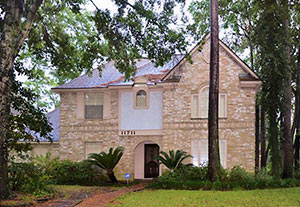 Wondering why a bunch of out-of-towners are afoot hunting down $214,000 homes (such as the Lakewood Forest number pictured here) to buy as investments in Houston — just as locals start to feel a bit jittery about the possibility of coming oil-price-drop aftershocks? The sudden outsider enthusiasm may stem in part from a roundup of “Best Buy Cities” published last month by Forbes, which purports to tell folks with extra cash on their hands Where To Invest In Housing In 2015. Number 3 on the list, which magazine writers in concert with a firm called Local Market Monitor came up with after exploring data on job opportunities and population increases — is Houston. But all 5 major Texas cities make it to the Top Ten. What, oil prices are falling? That just means you shouldn’t buy a home in Midland, declares the quoted expert, whose first name and credentials the article doesn’t bother to identify. (It’s Ingo Winzer, Local Market Monitor’s founder, who lives in North Carolina.) The list is revised annually, though between those efforts Forbes is generally busy producing a steady stream of clickbait ranking cities on various other criteria. [Forbes] Photo of 11711 Cedar Point Ct.: HAR
Wondering why a bunch of out-of-towners are afoot hunting down $214,000 homes (such as the Lakewood Forest number pictured here) to buy as investments in Houston — just as locals start to feel a bit jittery about the possibility of coming oil-price-drop aftershocks? The sudden outsider enthusiasm may stem in part from a roundup of “Best Buy Cities” published last month by Forbes, which purports to tell folks with extra cash on their hands Where To Invest In Housing In 2015. Number 3 on the list, which magazine writers in concert with a firm called Local Market Monitor came up with after exploring data on job opportunities and population increases — is Houston. But all 5 major Texas cities make it to the Top Ten. What, oil prices are falling? That just means you shouldn’t buy a home in Midland, declares the quoted expert, whose first name and credentials the article doesn’t bother to identify. (It’s Ingo Winzer, Local Market Monitor’s founder, who lives in North Carolina.) The list is revised annually, though between those efforts Forbes is generally busy producing a steady stream of clickbait ranking cities on various other criteria. [Forbes] Photo of 11711 Cedar Point Ct.: HAR
NEW ALEXAN BLAIRE HOUSE WILL EAT BLAIR HOUSE APARTMENTS ON BELLAIRE BLVD. 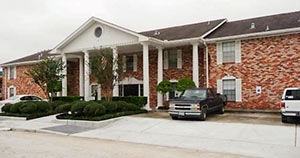 Even though the location isn’t specified, there’s enough detail in a press release put out by Bluerock Residential Growth REIT last week announcing its joint venture with Trammell Crow Residential to build a 269-unit apartment complex “2 miles from the Texas Medical Center” to identify where the new construction will take place. And to know that if it goes forward, it will spell doom for the Blair House Apartments, next door to the Palace Bowling Lanes, at 4139 Bellaire Blvd. in Southside Place. The biggest giveaway: The new project’s name, Alexan Blaire House, which combines Trammell Crow’s multifamily brand with a can’t-quit-it developer addiction to adding a trailing ‘E’ wherever it might stick. Plus, both Blair(e) houses sit on 4.16 acre sites. The existing 12-building complex of 2-story structures was built in 1963. [Bluerock Residential, via Houston Business Journal] Photo: Apartment Science
Even though the location isn’t specified, there’s enough detail in a press release put out by Bluerock Residential Growth REIT last week announcing its joint venture with Trammell Crow Residential to build a 269-unit apartment complex “2 miles from the Texas Medical Center” to identify where the new construction will take place. And to know that if it goes forward, it will spell doom for the Blair House Apartments, next door to the Palace Bowling Lanes, at 4139 Bellaire Blvd. in Southside Place. The biggest giveaway: The new project’s name, Alexan Blaire House, which combines Trammell Crow’s multifamily brand with a can’t-quit-it developer addiction to adding a trailing ‘E’ wherever it might stick. Plus, both Blair(e) houses sit on 4.16 acre sites. The existing 12-building complex of 2-story structures was built in 1963. [Bluerock Residential, via Houston Business Journal] Photo: Apartment Science
COMMENT OF THE DAY: THE PROBLEMS SPRAWL SOLVES  “. . . the concern about cities expanding out into the suburbs is about worker mobility and our ability to fund adequate infrastructure. That’s great if the woodlands, katy, and sugarland could become real functioning cities comparable to that of Houston. However, it’s unsustainable if you have poor transportation options affecting the supply of qualified labor and an undiversified industry base that leads to boom and bust cycles. We can barely afford Metro’s reach in central Houston and with more low-income workers being pushed further from the city’s core we will continue to lose workers from our supply of labor.
I love Houston the way it’s always been though. having multiple office centers spread across town helps keep housing demand distributed across a wider area rather than turning the central part of town into an enclave for well paid dual income families only. Allowing land to continue being gobbled up further and further out allows for affordable housing for new residents increasing our supply of labor. Anything that helps cities expand, even if endless suburban sprawl, and make better use of their existing resources and infrastructure is a positive to me.” [joel, commenting on Comment of the Day: West Houston’s Plan for Suburban Domination] Illustration: Lulu
“. . . the concern about cities expanding out into the suburbs is about worker mobility and our ability to fund adequate infrastructure. That’s great if the woodlands, katy, and sugarland could become real functioning cities comparable to that of Houston. However, it’s unsustainable if you have poor transportation options affecting the supply of qualified labor and an undiversified industry base that leads to boom and bust cycles. We can barely afford Metro’s reach in central Houston and with more low-income workers being pushed further from the city’s core we will continue to lose workers from our supply of labor.
I love Houston the way it’s always been though. having multiple office centers spread across town helps keep housing demand distributed across a wider area rather than turning the central part of town into an enclave for well paid dual income families only. Allowing land to continue being gobbled up further and further out allows for affordable housing for new residents increasing our supply of labor. Anything that helps cities expand, even if endless suburban sprawl, and make better use of their existing resources and infrastructure is a positive to me.” [joel, commenting on Comment of the Day: West Houston’s Plan for Suburban Domination] Illustration: Lulu
COMMENT OF THE DAY RUNNER-UP: WHAT DIFFERENCE DOES THE PRICE OF OIL MAKE TO HOUSTON REAL ESTATE?  “Let’s assume 100,000 people live and work in Houston and are employed, somehow, someway, by the energy industry. That’s a very high guesstimate, but let’s go with that. Now let’s assume one of four, or 25,000, are in danger of having their hours reduced or jobs eliminated. Again, a very high estimate. 25K folks in financial distress is less than one percent of the giant Houston SMA (5M or so). Even if you tripled the number to 75K folks living in Houston that are instantaneously released from their employment ’cause oil dropped to $25/barrel, that’s still less than 2% of the city’s population, and a blip on the ‘financial health of Houston’ radar. Home prices may dip a bit in Houston, but that may be more due to a massive number of shit houses being constructed and sold cheap than $1.95/gallon gas.” [c.l., commenting on Houston Housing Market Reaches All-Time Highs — Before It Crashes, Dips a Little, Remains Steady, or Climbs Further] Illustration: Lulu
“Let’s assume 100,000 people live and work in Houston and are employed, somehow, someway, by the energy industry. That’s a very high guesstimate, but let’s go with that. Now let’s assume one of four, or 25,000, are in danger of having their hours reduced or jobs eliminated. Again, a very high estimate. 25K folks in financial distress is less than one percent of the giant Houston SMA (5M or so). Even if you tripled the number to 75K folks living in Houston that are instantaneously released from their employment ’cause oil dropped to $25/barrel, that’s still less than 2% of the city’s population, and a blip on the ‘financial health of Houston’ radar. Home prices may dip a bit in Houston, but that may be more due to a massive number of shit houses being constructed and sold cheap than $1.95/gallon gas.” [c.l., commenting on Houston Housing Market Reaches All-Time Highs — Before It Crashes, Dips a Little, Remains Steady, or Climbs Further] Illustration: Lulu
TESLA OR SPACEX OR SOMEBODY ELON MUSK KNOWS IS PLANNING TO BUILD A 5-MILE HYPERLOOP TEST TRACK, PROBABLY IN TEXAS  Speaking at a Texas transportation forum in Austin today, Elon Musk said plans are afoot to build a 5-mile test track for the Hyperloop pneumatic-tube-like transportation system the entrepreneur and engineer and billionaire outlined 18 months ago — and that the “leading candidate” for the site was somewhere in Texas. The track — a low-pressure environment inside a set of steel tubes, meant to allow pods to move inside at speeds of up to 760 mph — would be privately funded, but open to universities and research institutions interested in developing and iterating on the prototype transportation technology. In a couple of follow-up tweets, Musk described the test track as a site where students and others could test out their own pod designs, and even suggested a Formula SAE-style annual student Hyperloop pod racer competition. Musk’s SpaceX launch facility is located near Brownsville. Not coincidentally, the Tesla CEO said he also plans to reintroduce legislation this year that would end Texas laws that block the electric-car manufacturer from selling directly to consumers. [Ars Technica; The Verge; previously on Swamplot] Drawing of Hyperloop prototype design: Tesla Motors
Speaking at a Texas transportation forum in Austin today, Elon Musk said plans are afoot to build a 5-mile test track for the Hyperloop pneumatic-tube-like transportation system the entrepreneur and engineer and billionaire outlined 18 months ago — and that the “leading candidate” for the site was somewhere in Texas. The track — a low-pressure environment inside a set of steel tubes, meant to allow pods to move inside at speeds of up to 760 mph — would be privately funded, but open to universities and research institutions interested in developing and iterating on the prototype transportation technology. In a couple of follow-up tweets, Musk described the test track as a site where students and others could test out their own pod designs, and even suggested a Formula SAE-style annual student Hyperloop pod racer competition. Musk’s SpaceX launch facility is located near Brownsville. Not coincidentally, the Tesla CEO said he also plans to reintroduce legislation this year that would end Texas laws that block the electric-car manufacturer from selling directly to consumers. [Ars Technica; The Verge; previously on Swamplot] Drawing of Hyperloop prototype design: Tesla Motors
SORRY, NO MATTRESS STORE CAN SNEAK INTO HIGHLAND VILLAGE WITHOUT SOMEBODY NOTICING 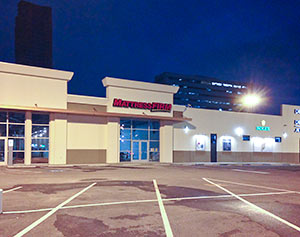 Here’s a piece of hot retail news the likes of which has not been encountered since . . . well, since Swamplot broke the story that the Walgreens near the corner of Westheimer and Weslayan will be moving across both streets to the former Fresh Market spot: A reader has ID’d a new neighbor moving into the former Rice Epicurean shopping center, next to said future Walgreens. It’ll be . . . wait for it . . . a Mattress Firm going into the 3743 Westheimer Rd. address, as evidenced by the familiar red sign now glowing brightly above the future front door shown above. Intriguing bonus tip, for all you Highland Village area store-opening watchers to chew over: “There were two vacant spots in the center when Fresh Market was there and it looks like the other one is leased as there’s a sign in the window for construction but does not identify who is moving in.” Photo: Swamplot inbox
Here’s a piece of hot retail news the likes of which has not been encountered since . . . well, since Swamplot broke the story that the Walgreens near the corner of Westheimer and Weslayan will be moving across both streets to the former Fresh Market spot: A reader has ID’d a new neighbor moving into the former Rice Epicurean shopping center, next to said future Walgreens. It’ll be . . . wait for it . . . a Mattress Firm going into the 3743 Westheimer Rd. address, as evidenced by the familiar red sign now glowing brightly above the future front door shown above. Intriguing bonus tip, for all you Highland Village area store-opening watchers to chew over: “There were two vacant spots in the center when Fresh Market was there and it looks like the other one is leased as there’s a sign in the window for construction but does not identify who is moving in.” Photo: Swamplot inbox
COMMENT OF THE DAY: WEST HOUSTON’S PLAN FOR SUBURBAN DOMINATION  “Houston does not have a centralized downtown district. After Gerry Hines built the Galleria, the city fractured into numerous regional shopping centers and has remained decentralized since. Perhaps Houston functions better this way.
Humpty Dumpty fell off the wall and all the King’s men cannot put Humpty Dumpty back together again.
MetroNational and Midway Cos. are determined to reconstruct Houston with a new centralized downtown district in CityCentre. They envision Memorial Drive and Gessner as commercial 8-lane thoroughfares. They envision the corridor of residential neighborhoods between the Katy Freeeway and Memorial Drive as one big mega shopping center, an expansion of Memorial City that stretches on for miles. They envision deed restricted neighborhoods of Walnut Bend and Briargrove Park as office parks. Don’t believe me? Just go to the West Houston Association website and click on 2050 map. They are serious about remapping Houston. And what are they going to do with all the storm water run-off from these commercial buildings? They are going to channel it into Buffalo Bayou, of course. To do this they have to deforest the bayou and widen and deepen and concrete it. They are determined to do it. And where are they going to get the money to do this? Out of TIRZ 17 and MetroNational Bank.” [Memorial Resident, commenting on Comment of the Day: Houston’s Westward Tilt] Illustration: Lulu
“Houston does not have a centralized downtown district. After Gerry Hines built the Galleria, the city fractured into numerous regional shopping centers and has remained decentralized since. Perhaps Houston functions better this way.
Humpty Dumpty fell off the wall and all the King’s men cannot put Humpty Dumpty back together again.
MetroNational and Midway Cos. are determined to reconstruct Houston with a new centralized downtown district in CityCentre. They envision Memorial Drive and Gessner as commercial 8-lane thoroughfares. They envision the corridor of residential neighborhoods between the Katy Freeeway and Memorial Drive as one big mega shopping center, an expansion of Memorial City that stretches on for miles. They envision deed restricted neighborhoods of Walnut Bend and Briargrove Park as office parks. Don’t believe me? Just go to the West Houston Association website and click on 2050 map. They are serious about remapping Houston. And what are they going to do with all the storm water run-off from these commercial buildings? They are going to channel it into Buffalo Bayou, of course. To do this they have to deforest the bayou and widen and deepen and concrete it. They are determined to do it. And where are they going to get the money to do this? Out of TIRZ 17 and MetroNational Bank.” [Memorial Resident, commenting on Comment of the Day: Houston’s Westward Tilt] Illustration: Lulu
COMMENT OF THE DAY: HOUSTON’S WESTWARD TILT 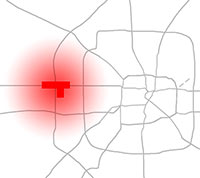 “News flash: the energy corridor is now the economic center of town. Downtown is just where companies go to save on rents bc the EC might be too pricey. There are — of course — big legacy companies still downtown but three super majors are between HW 6 and Dairy Ashford.” [Houstonian, commmenting on Another Chelsea Gets Away] Illustration: Lulu
“News flash: the energy corridor is now the economic center of town. Downtown is just where companies go to save on rents bc the EC might be too pricey. There are — of course — big legacy companies still downtown but three super majors are between HW 6 and Dairy Ashford.” [Houstonian, commmenting on Another Chelsea Gets Away] Illustration: Lulu
ATLANTA COMPANY UPGRADING ENERGY CORRIDOR, WOODFOREST APARTMENT COMPLEXES FROM COUNTRY TO CITY  A note on the purchase of 2 Houston apartment complexes by Atlanta’s Radco Companies noted in this morning’s roundup of Headlines: Urbanization — in advance or in recognition of actual changes-on-the-ground — appears to be part of the plan. In taking over the properties from Fannie Mae, Radco has renamed the 122-unit Country Place apartments at 1015 Country Place Dr. in the Energy Corridor to City Terrace. And the 458-unit Saddle Ridge apartments (pictured here) at 12800 Woodforest Blvd. at the northern tip of Riviera East, east of Uvalde Rd., is shedding its rural shadings under new ownership as well: It’s new name is City Crossing Apartments. The company also plans to spend an average of $13,300 per unit in upgrades. [Real Estate Bisnow; more info] Photo: Radco Companies
A note on the purchase of 2 Houston apartment complexes by Atlanta’s Radco Companies noted in this morning’s roundup of Headlines: Urbanization — in advance or in recognition of actual changes-on-the-ground — appears to be part of the plan. In taking over the properties from Fannie Mae, Radco has renamed the 122-unit Country Place apartments at 1015 Country Place Dr. in the Energy Corridor to City Terrace. And the 458-unit Saddle Ridge apartments (pictured here) at 12800 Woodforest Blvd. at the northern tip of Riviera East, east of Uvalde Rd., is shedding its rural shadings under new ownership as well: It’s new name is City Crossing Apartments. The company also plans to spend an average of $13,300 per unit in upgrades. [Real Estate Bisnow; more info] Photo: Radco Companies
WORLD’S LARGEST AIR CONDITIONING MANUFACTURER TO BUILD GIANT COMFORTPLEX AT NORTHERN REACHES OF KATY PRAIRIE  Ah, Houston industry! Oil may be down, but air conditioning is booming — and ready to do its part to further our fine city’s sprawl-ward spread. Ralph Bivins reports this morning that Japanese HVAC giant Daikin Industries, which paid $3.7 billion back in 2012 to buy Houston’s Goodman Global, will build a $417 million, 4,000,000-sq.-ft. manufacturing and logistics campus on virgin prairie southeast of Hockley, off U.S. 290 a good 3 miles west of the Grand Parkway. Dubbed the “Comfortplex,” the facility (portrayed in the rendering above) will consolidate current company operations in both Tennessee and Texas, and increase the company’s Houston-area workforce to approximately 4,000 employees. The Comfortplex will replace an existing 525,000-sq.-ft. Goodman air-conditioner factory near Loop 610 and 290 when it opens in 2016, Bivins notes. The company produces ducted and ductless AC systems under the Daikin, Goodman, and Amana brand names. [Realty News Report] Rendering: Daikin Industries
Ah, Houston industry! Oil may be down, but air conditioning is booming — and ready to do its part to further our fine city’s sprawl-ward spread. Ralph Bivins reports this morning that Japanese HVAC giant Daikin Industries, which paid $3.7 billion back in 2012 to buy Houston’s Goodman Global, will build a $417 million, 4,000,000-sq.-ft. manufacturing and logistics campus on virgin prairie southeast of Hockley, off U.S. 290 a good 3 miles west of the Grand Parkway. Dubbed the “Comfortplex,” the facility (portrayed in the rendering above) will consolidate current company operations in both Tennessee and Texas, and increase the company’s Houston-area workforce to approximately 4,000 employees. The Comfortplex will replace an existing 525,000-sq.-ft. Goodman air-conditioner factory near Loop 610 and 290 when it opens in 2016, Bivins notes. The company produces ducted and ductless AC systems under the Daikin, Goodman, and Amana brand names. [Realty News Report] Rendering: Daikin Industries
THE SWAMPLOT AWARDS YOU MIGHT HAVE MISSED  Did it seem like the holiday season went by in a glittery flash? If so, maybe you didn’t have time to take in the wonders of the 2014 Swamplot Awards for Houston Real Estate. It’s the annual chance for this publication’s readers to honor local standouts with an assortment of accolades. 2014 may be over, but you can still revel over who or what your peers tagged as their Favorite Houston Design Cliche, Best Demolition, Best Sign of the New Houston, and other honorifics in 7 separate categories — simply by reading this accounting of the winners. Equally entertaining and informative is this roundup of the runners-up. Thanks again to all the worthy contestants and commentators — your rich contributions to this city (and this website) make the Swampies an annual endeavor worth repeating.
Did it seem like the holiday season went by in a glittery flash? If so, maybe you didn’t have time to take in the wonders of the 2014 Swamplot Awards for Houston Real Estate. It’s the annual chance for this publication’s readers to honor local standouts with an assortment of accolades. 2014 may be over, but you can still revel over who or what your peers tagged as their Favorite Houston Design Cliche, Best Demolition, Best Sign of the New Houston, and other honorifics in 7 separate categories — simply by reading this accounting of the winners. Equally entertaining and informative is this roundup of the runners-up. Thanks again to all the worthy contestants and commentators — your rich contributions to this city (and this website) make the Swampies an annual endeavor worth repeating.
ANOTHER CHELSEA GETS AWAY 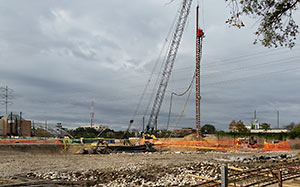 Good morning! It’s 2015, oil is already checking out the territory south of $50 a barrel, and Swamplot is ready to begin its coverage of cancellation and delay announcements from real estate developers. We’ll start this one gently, with an Inside the Loop project you probably hadn’t even heard of — though its name certainly sounds familiar: The developers of Chelsea Museum District, a proposed apartment complex atop a podium garage with a bit of retail thrown in planned for the north side of Blodgett St. between Crawford and La Branch, tell the HBJ‘s Paul Takahashi they are “contemplating holding [the] project to see how the multifamily market fares amid low oil prices.” But don’t confuse Trans Unity Investment’s Chelsea Museum District with another project less than a mile to the west at 4 Chelsea Blvd. that used to be called Chelsea Montrose, but has since been renamed The Carter (no, not kidding), and which developer StreetLights Residential has already begun building (see construction photo above from just before Christmas). [Houston Business Journal] Photo: Marc Longoria
Good morning! It’s 2015, oil is already checking out the territory south of $50 a barrel, and Swamplot is ready to begin its coverage of cancellation and delay announcements from real estate developers. We’ll start this one gently, with an Inside the Loop project you probably hadn’t even heard of — though its name certainly sounds familiar: The developers of Chelsea Museum District, a proposed apartment complex atop a podium garage with a bit of retail thrown in planned for the north side of Blodgett St. between Crawford and La Branch, tell the HBJ‘s Paul Takahashi they are “contemplating holding [the] project to see how the multifamily market fares amid low oil prices.” But don’t confuse Trans Unity Investment’s Chelsea Museum District with another project less than a mile to the west at 4 Chelsea Blvd. that used to be called Chelsea Montrose, but has since been renamed The Carter (no, not kidding), and which developer StreetLights Residential has already begun building (see construction photo above from just before Christmas). [Houston Business Journal] Photo: Marc Longoria
THE CENTER OF EVERYTHING, ONCE YOU DRIVE ALL THE WAY OUT THERE 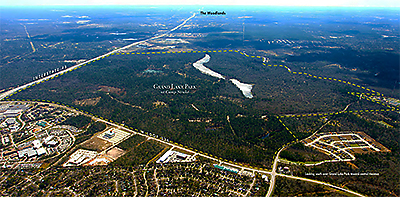 The latest event in the growing trend of establishments far from the center of the city adopting names that convey an aura of centrality comes from the firm turning the former Camp Strake Boy Scout facility just south of Conroe into a large suburban residential development. Henceforth, Johnson Development announced today, the 2,046-acre property just west of I-45 and south of Loop 336 — north of The Woodlands — shall be known as Grand Central Park. [Prime Property; previously on Swamplot] Photo: Jones Lang LaSalle
The latest event in the growing trend of establishments far from the center of the city adopting names that convey an aura of centrality comes from the firm turning the former Camp Strake Boy Scout facility just south of Conroe into a large suburban residential development. Henceforth, Johnson Development announced today, the 2,046-acre property just west of I-45 and south of Loop 336 — north of The Woodlands — shall be known as Grand Central Park. [Prime Property; previously on Swamplot] Photo: Jones Lang LaSalle
USPS NOW SAYS IT WILL CLOSE AND SELL THE HEIGHTS POST OFFICE 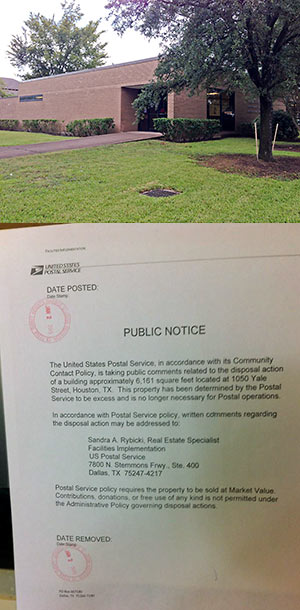 A new public notice taped to the door of the Heights Finance Station post office at the corner of Heights Blvd. and 11th St. last Friday indicates the U.S. Postal Service has moved on from “considering” moving out of the property and is now prepared for a full-on “disposal” action: “This property has been determined by the Postal Service to be excess and is no longer necessary for Postal operations,” reads the notice, which also indicates that “Postal Service policy requires the property to be sold at Market Value.” Though public comments are still being encouraged, it typically takes more than a few discouraging words to prevent a local post office from shutting down. The 6,161-sq.-ft. building at 1050 Yale St. sits on more than an acre of land. [Previously on Swamplot] Photos: Swamplot inbox (post office); Nick Panzarelli (notice)
A new public notice taped to the door of the Heights Finance Station post office at the corner of Heights Blvd. and 11th St. last Friday indicates the U.S. Postal Service has moved on from “considering” moving out of the property and is now prepared for a full-on “disposal” action: “This property has been determined by the Postal Service to be excess and is no longer necessary for Postal operations,” reads the notice, which also indicates that “Postal Service policy requires the property to be sold at Market Value.” Though public comments are still being encouraged, it typically takes more than a few discouraging words to prevent a local post office from shutting down. The 6,161-sq.-ft. building at 1050 Yale St. sits on more than an acre of land. [Previously on Swamplot] Photos: Swamplot inbox (post office); Nick Panzarelli (notice)

